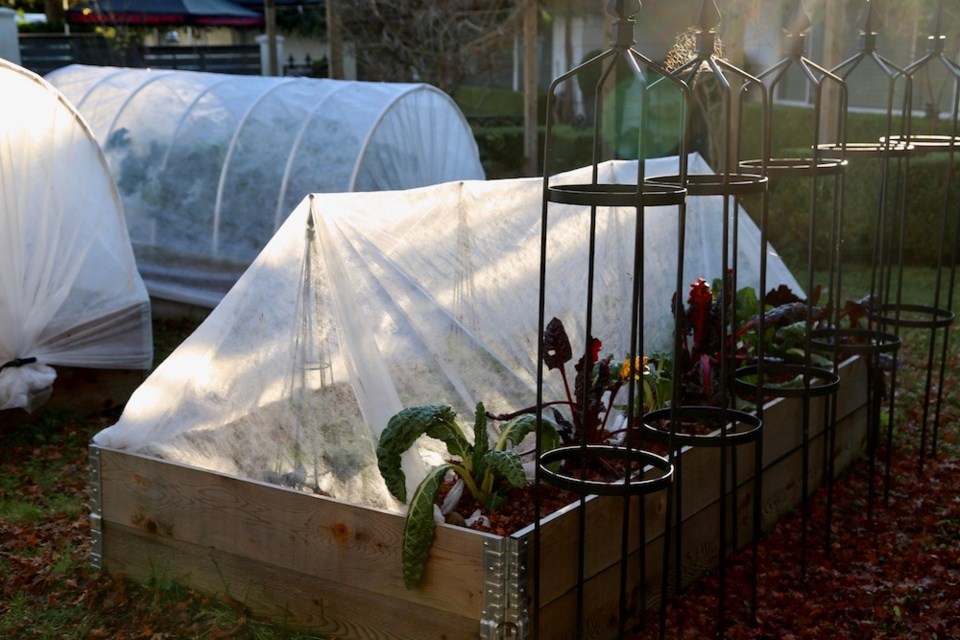During the third week of October every year, more or less, Jack Frost visits our neighbourhood.
His initial appearance is fleeting and slight, but most definitely it is a warning; an icy cold reminder to dress our beds in flannel sheets, and to dress the food garden too, in its winter pyjamas.
For us that means covering the three small raised beds with lightweight fleece over low wire hoops. Astro arugula, three varieties of carrots, remnant turnips, and rutabaga do well through much of the winter despite their part sun location. In a few of the beds, thousands of tiny Japanese maple leafs have settled in for the season, forming a thin blanket of mulch.
Three of our six larger raised beds, those closest to the low winter sun, are ideally suited for cold frames, which were built simply from 2x2 cedar, and greenhouse polycarbonate. The top and side panels are easily fastened together in the fall, then taken apart again in the spring, for storage in the garage.
In these beds, I plant a variety of beautiful radicchio, mustards, winter purslane, spinach, endive, and rapini — all started from seed mid-August in the greenhouse. It is fascinating to watch the radicchio and leafy greens freeze and thaw throughout the winter, growing more resilient and delicious over time. The trick is, to let them thaw completely before harvesting. To do otherwise ends in a mushy mess.
We cover the remaining three large raised beds, those partially shaded by the cold frames, with medium-weight fleece over hoops. Previously, we used flexible 3/4-inch PVC pipe for the hoops, sliding the ends over short lengths of coated re-bar sunk into the soil around the perimeter. This worked very well and was inexpensive to assemble.
We are trying a more subtle approach this year by using a combination of six-foot lengths of metal hoop track that can be joined together with fasteners, and adjustable-height anchors that rest against the inside frame of the beds. Five high hoops per standard 4x8 bed should give us plenty of height where we need it, for growing kalettes, sprouting broccoli, broccolini, winter kales, collards, and Brussels sprouts. These plants too, were started from seed, mid-summer.
Last year, the PVC hoops held up nicely to the weight of wet snow and icy fleece. I have high hopes for the steel hoops, but only time will tell. I may well be making frequent visits to the garden, with a broom.
I must now get on with the mulching and fleecing, transplanting, covering, and protecting, because soon the frost will turn hard, and the short window of opportunity to ‘get it all done’ will be closed. Winter will settle in swiftly, leaving a melty mess of green, grey and sodden brown to remind us who is in charge.
As if to say, “I warned you. I did. I sent Jack.”
I love the ceremony and the pace of winter food gardening. It is deliberate to be sure, and inconvenient. Come January, as I am cooking on the fly, I cannot just run outside quickly for some carrots, beets, or collards. More often than not it is raining, and most certainly it is sodden, so on go the boots and the raincoat for a trip to the beds, but not before making a side trip for a bucket to contain the muddy spoils.
With any luck, my quarry waits in the cold frames, which while easy to open and close, almost always send an unwelcome cold and wet trickle of water down into the arm of my raincoat. Most often, visits to the beds involve a kneel or two in wet grass to untie and re-tie fleece, which when balancing bucket and snips in cold wet fingers, can be a challenge.
Sound delicious? Indeed it is. Winter food gardening feeds our bodies, but more important, it takes us outside to feed our souls; to breathe deep the energy of the ages blowing down from the beautiful north shore mountains, and to bask in the cleanest water on earth.
I revel in it. For a short time at least, before heading back inside to dry off and put on my winter pyjamas.
Laura Marie Neubert is a West Vancouver-based urban permaculture designer. Follow her on Instagram @upfrontandbeautiful, learn more about permaculture by visiting her Upfront & Beautiful website or email your questions to her here.
For a taste of permaculture, click on the YouTube link below:
(Video - Courtesy of West Vancouver Memorial Library)



